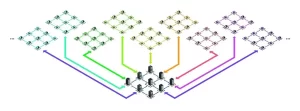Blockchain sharding is a way to make blockchain networks more efficient. Imagine you have a big puzzle to solve but instead of doing it all by yourself, you have friends who can help you. Sharding is like dividing that big puzzle into smaller pieces called shards. Each person in your group gets a shard to solve. This way, everyone works on their own piece making the puzzle-solving faster and easier.
In the blockchain world, sharding works similarly.
Instead of one computer handling all the work for the entire network, the network is divided into smaller groups called shards.
Each shard has its own set of data and a specific group of computers takes care of that shard.
The clever thing is that even though each shard has its own data, all the computers in the network can still see and verify all the transactions. This makes sure the blockchain stays secure and decentralized.
You might like it: What are BRC-20 Tokens?

How Does Blockchain Sharding Work?
When a transaction is made on a blockchain network, it gets recorded in a block and added to a long chain of blocks. This chain is like a big web of computers that work together to keep the network secure.
With sharding, this web is divided into smaller groups. Each group has its own shard to manage. All the shards still share the data with each other but each shard has its own main group of computers responsible for handling its task. This reduces the burden on other computers and makes the network faster and more efficient.
Benefits:
- Improve scalability: Sharding makes the blockchain network faster and able to handle more transactions.
- Reduce transaction fees: By dividing the workload among different shards, the overall cost of processing transactions goes down.
- Reduce workload on individual nodes: Sharding distributes the work more evenly, preventing any single computer from being overloaded.
- Increase network participation: Sharding encourages more people to participate in the network because it becomes more accessible and efficient.
In sharding, “workload” means the tasks given to different groups of computers. Sharding divides the workload among these groups, making the network faster and preventing overload.
You can present own thoughts as comment about the topic. Moreover, you can follow us on Telegram and YouTube channels for the kind of the news.


